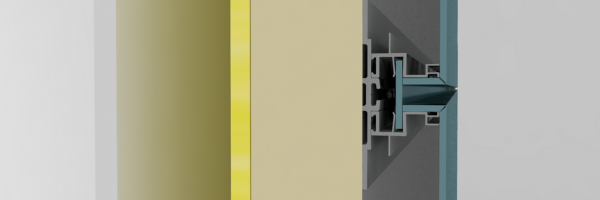The choice between using polyiso and mineral wool insulation depends on a variety of factors, including the specific application, cost, environmental concerns, and building codes.
RapidWrapCI is a continuous insulation system manufactured by Fairview Architectural North America, which is designed to provide an energy-efficient, sustainable building envelope.
Before we jump in, let’s begin by understanding what Continuous Insulation (CI) is:
What is Continuous Insulation (CI)?
Continuous insulation (CI) is a method of insulating the exterior of a building, providing a continuous layer of thermal protection to the building envelope. It is designed to eliminate thermal bridging, which occurs when heat is transferred through materials that conduct heat more easily than others, such as metal framing or studs.
What are the benefits of Continuous Insulation (CI)?
The use of Continuous Insulation (CI) is becoming increasingly popular in building construction, as it can improve energy efficiency, reduce heating and cooling costs, and improve indoor comfort levels. Additionally, it can also help to prevent moisture problems and increase the durability of the building envelope.
What is the difference between Polyiso insulation and Mineral Wool insulation?
Polyisocyanurate insulation (polyiso) and mineral wool are two common types of insulation that are used in a Continuous Insulation system. Both materials have their advantages and disadvantages, and which one is better for you will depend on your specific needs and priorities for your particular project.
Polyiso
Polyiso is a rigid foam insulation that is typically used on the exterior of commercial and residential buildings. It has a high R-value per inch of thickness, which means it provides excellent insulation for a relatively thin layer of material. It’s lightweight, easy to handle, and can be cut to fit the desired shape and size. However, polyiso is not as fire-resistant as mineral wool, and it can melt and release toxic fumes when exposed to high temperatures.
Mineral Wool
Mineral Wool, also known as Rock Wool or Stone Wool, is an insulation material made from natural rock or slag. It is a non-combustible material that can withstand high temperatures without melting or releasing toxic fumes. It is often used in industrial applications, such as furnaces and boilers, as well as in commercial and residential buildings. Mineral Wool is also excellent at soundproofing and can help to reduce noise transmission between rooms. However, mineral wool is typically more expensive than polyiso and can be heavier and more difficult to handle.
Here are some key differences between the two:
- Thermal Resistance: Both polyiso and mineral wool provide excellent thermal resistance, but polyiso typically has a higher R-value per inch of thickness than mineral wool. However, mineral wool can be compressed to a higher density, which can compensate for its lower R-value per inch.
- Fire Resistance: Mineral Wool is generally considered more fire-resistant than Polyiso. Mineral wool is non-combustible and can withstand temperatures up to 2,150 degrees Fahrenheit, whereas Polyiso can melt and burn at lower temperatures.
- Moisture Resistance: Polyiso is more resistant to moisture than Mineral Wool, which can absorb water and lose its insulating properties. However, both materials can be treated to improve their moisture resistance.
- Environmental Concerns: Mineral Wool is made from natural materials, such as volcanic rock or slag, and is considered more environmentally friendly than Polyiso, which is made from petrochemicals. However, both materials can be recycled and reused.
- Cost: Polyiso is generally more expensive than Mineral Wool, but its higher R-value per inch can lead to savings in the long run by reducing energy costs.
Both Polyiso and Mineral Wool have their advantages and disadvantages, and the choice depends on you and your projects specific needs and priorities. If fire resistance and soundproofing are your primary concerns, Mineral Wool may be the better choice. If you are looking for a lightweight, cost-effective insulation solution that can be easily installed, Polyiso may be the better option for you.
Do Continuous Insulation (CI) systems meet NFPA 285 code requirements?
Continuous Insulation (CI) can meet the requirements of NFPA 285, which is a standard fire test method for evaluating the fire propagation characteristics of exterior wall assemblies containing combustible components. The NFPA 285 test is intended to evaluate the fire performance of exterior wall assemblies that incorporate combustible components, such as insulation, in order to determine whether they are suitable for use in non-combustible construction.
To meet the requirements of NFPA 285, a wall assembly must pass a fire test that simulates a multi-story fire scenario. The test involves installing the wall assembly on a test apparatus and exposing it to a fire source located at the base of the wall. The fire is then allowed to spread up the wall, and the assembly is evaluated based on its ability to resist flame spread and prevent the fire from spreading and moving to other floors or to adjacent buildings.
Continuous Insulation (CI) systems can be designed and tested to meet NFPA 285 requirements by using non-combustible insulation materials or by engineering the wall assembly in such a way that combustible materials used will not cause the test to fail. It is important, however, that the actual project is built in accordance with the wall assembly as detailed in the test including the air gap, fire stop, baffles, window flashing, and other features of the design. Additionally, the cladding and other components of the wall assembly must also be evaluated to ensure that they meet the fire performance requirements of the test.
It is important to note that meeting NFPA 285 requirements is only one aspect of ensuring fire safety in building construction. Other factors, such as proper design and installation of fire barriers, smoke control systems, and fire suppression systems, are also critical to ensuring the safety of building occupants in the event of a fire.
While most CI systems use standoffs and subgirt systems to attach the cladding to the substrate behind the insulation, RapidWrapCI is the only continuous insulation system that eliminates the need for these standoffs. Meaning that the insulation is truly continuous, without penetrations other than screws. This not only increases the thermal protection of the building envelope, but also eliminates all the materials and labor associated with installing stand-offs across the entire wall assembly.
To learn more from the links below:
– Understanding Rain Screen Wall Systems (Metal Construction Association)
– What 2 Questions should you ask when specifying a Continuous Insulation wall system?
If you would like to discuss Continuous Insulation further with our sales team, call 860-242-2711 or email helpdesk@fairview-na.com.



